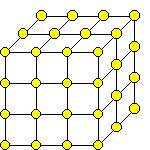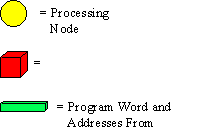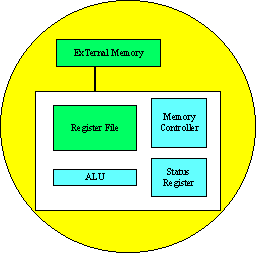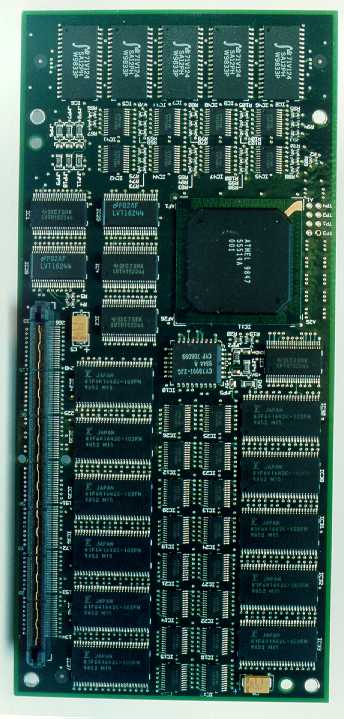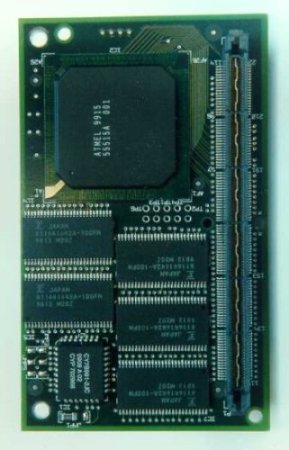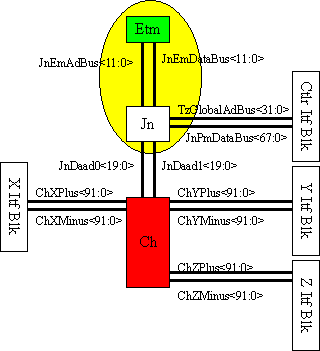APEmille project
A PARALLEL PROCESSOR IN THE TERAFLOPS RANGE
This document describes APEmille, a scalable 3-D SIMD parallel computer in the Teraflop range. This machine is very efficient for Lattice Gauge Theory simulations as well as for a broader class of numeric applications requiring massive intensive floating point computations.
Topology
An APEmille machine is a 3D grid of processing nodes with hardware data links between the 3D first neighbouring nodes. The smallest machine is the single Processing Board (PB) where are placed 8 processing nodes with a 2x2x2 topology, (cube). Arranging togheter more PBs it's possible to have more complicated, greater and faster machines.
Hierarchical Hardware Topology
The yellow cubes in this rappresentation are single APEmille boards with their 8 processing nodes supposed as placed at the vertices of the cube.
- Board: 8 Nodes (2*2*2 topology)
- SubCrate: 4 Boards (2*2*8 topology)
- Crate: 4 SubCrates -16 Boards (2*8*8 topology)
- Tower: 4 Crates - 64 Boards (8*8*8)
- APEMille: 4 Towers - 256 Boards(32*8*8)
Performances
The following table reports the performance of the different configuration of an APEmille system: the maximum performance are about 1TeraFlops for the 66 MHz machine
Comparing these performances, with an APE100 machine we find out that it's possible to replace an entire APE100 tower (25 GigaFloaps) with a APEmille SubCrate.
| APEmille partitions | ||||
|---|---|---|---|---|
| Partition | # of nodes | topology | volume | Peak FP Performance |
| Processing node | 1 | 4 cm^sup2; | 528 MFlops | |
| Board | 8 | 2*2*2 | 60x60cm | 4.2 GFlops |
| Unit | 8x4 | 2*2*8 | ∼.1 m³ | 16.8 GFlops |
| Crate | 8x16 | 2*8*8 | ∼.5 m³ | 66 GFlops |
| Rack | 8x32 | 8*8*8 | ∼ 2 m³ | 264 GFlops |
| APEMille | 8x128 | 32*8*8 | ∼ 8 m³ | 1 TFlops |
Processing Board
Fore each APEmille PB a CPU takes care of the program flow and drives the communication protocol with the host network. The CPU broadcasts a VLIW (Very Long Instruction Word) to the 8 Processing Nodes located on each PB. At the same time, as a result of its calculations, the CPU broadcasts a Global Address to the Processing Nodes. The Nodes can access their own local memory using this Global Address either directly or after adding a local offset to it, thus producing a local address.
The 8 Processing Nodes of a Board are arranged in a cubic lattice (a 2x2x2 topology). Each processing node has an arithmetic and logic unit including floating point adders, multipliers, a large multiport register file plus a memory controller with address generation capability, interfacing to local memory. Integer and bitwise operations and local addressing are some of the new main features of the Processing Nodes.
The first APEmille systems, based on presently available Syncronous Dynamic Ram and VLSI ASIC technologies, will adopt a 66 MHz, 528 MFlops processor. We expect however that the clock frequency may eventually increase up to 100 MHz. A 2048 100 MHz nodes system would have a peak performance of 1.6 TeraFlops.
According to our application requirements, the size of the local memory of each Processing Node will range from 2 to 8 MWord. Through a Communication Device each Processing Node directly accesses the data on its own 6 neighbouring Nodes. Some routing capabilities allow of the comunication device (slower) access to far-away nodes.
The Processing Board hosts:
- 1 CPU
- 8 Processing Nodes,
- 1 Communication Device
- required memories.
Scheme of connections among the 8 nodes of a PB
Cmille is the custom chip which takes care of the remote data communications between processing nodes.
Tmille is the custom processor which controls the instruction flow and global addressing of each APEMille SIMD partition (a minimum of 8 processing nodes). Tmille is connected to the Host, to its own data memory, to an instruction memory and to the Communication Device. It also drives the Address Bus. There is a major difference from the Ape100 machine where one controller CPU normally drives 128 nodes and is housed in a different board.
The Processing Node is composed of a floating point processor (called JMILLE) which drives its own Local Memory, receives Instructions and Global Addresses from TMILLE and communicates with the Communication Device (CMILLE).
The Communication Device also has a channel connected to the CPU, and through this pathway, to the Host. Through this pathway the Host loads the program and data memories of the floating point processor.
All the CPUs and all the Nodes of a SIMD machine partition execute the same instruction. Each PB sends its Local Signals to a Root Board and receives Global Signals from it, in order to manage Synchronisation, Exceptions and Global Flow Control Conditions.
Each Processing Board interfaces the Host through a dedicated synchronous channel (APE Channel) going from the CPU to the Host Interface.
Processing Node
Each Processing Node is composed of a JMILLE floating point processor, attached to a SDRAM local memory. The Memory Controller inside Jmille generates addresses for the External Memory summing up a Global Address given by Tmille and a Local Address computed by Jmille itself. This way each APEMille Processing Node is able to generate a different Memory Address. The five addresses needed by the Multiport Register File are fixed by our compiler at compile time, and therefore distributed to Jmille inside the Program Word. This is obtained by means of our VLIW (Very Long Instruction Word) compiling technology.
Each Processing Node generates Status Signals (Global conditions, Exceptions etc.). These Status Signals are collected into a Global Status Return managed by the Control System. This connection allows the Control System to execute flow control instructions based on simultaneous logical conditions produced by the set of Processing Nodes. The instruction word read by JMILLE specifies the set of addressed location inside the large multiport Register File internal to JMILLE, and controls the Arithmetic Devices inside the processing node. Moreover it specifies Local Conditional Operation, Local Addressing functions, and Special Arithmetic function calculations to be performed by JMILLE.
Scheme of a Processing Node
- Jmille : is the APEMille custom arithmetic processor with hardware supporting arithmetic, logical and bitwise operations on complex, double precision, single precision and integer data types.
- External Memory (ETM) : A SDRAM memory, directly attached to Jmille and controlled by Jmille itself, where all the data related to the node processing are stored.
Tmille
Tmille is a VLSI device that includes all the control functions of the APEmille PB.
Tmille is composed of the following blocks:
- Decoder block: the interface to the host
- APEcontroller (ZCPU): controls the program flow (main sequencer, io_block, branch and address unit) and performs integer arithmetic and logical computations
- register block: status & exception registers
- Switch block: delivers data from the APE Channel to the proper PB device in download mode.
The host is able to access all the PB devices and memories through the APE Channel which is connected only to Tmille. Tmille is the APE Channel front end to the Processing Board. It decodes the APE Channel protocol and manages the data transfer between the APE Channel master (the host) and the requested APEmille device (memory or register). Tmille can assert the PB status according to the host requests and to the program requests. Two status are possible:
- system mode
- run mode.
In system mode the host can access all the PB memories and all Tmille, Jmille and Cmille registers. Tmille allows the host to download the executable file to the program memory and to download or upload data to/from its own data memory, the Jmilles's data memories and all the PB registers. The switch bus is used to send data from Tmille to the proper PB device.
In run mode the user program is actually running and the host cannot access neither the memories nor any Jmille or Cmille registers. Tmille waits over the APE Channel for a stop running request from the host.
The system_mode/run_mode switching must be performed accordingly to the Root Board directives to achieve the synchronisation of the Processing Boards. For this reason some signals ( halt, ifstatus .... ) must be delivered to the Root Board which collect them and send back the corresponding global signals to the PBs. (see PB Interconnections)
The APEcontroller takes care of the user program flow. In system mode the APEcontroller is idle. In run mode the APEcontroller runs the integer global part of the user program. The APEcontroller instruction is extended with the instruction to control the Jmille and Cmille units. Tmille, in run mode, halts the APEcontroller (switching into system mode) when the glb_halt flag is raised. Tmille in system mode starts the APEcontroller execution (switching into run mode) when the Root Board releases the glb_halt flag. The APEcontroller, in run mode, will conditionally branch on request testing the glb_ifstatus signal. Tmille raises the halt signal when the APEcontroller reaches a HALT instruction in the code or when an unmaskered exception occurs.
Tmille scheme
Control Word
Tmille is a VLIW processor. Its Control Word is 80 bits long and is composed of 10 fields as described in the following table.
| EDAC | IO | ALUFLOW | P4 | P3 | P2 | P1 | P0 | AGU | DISPL |
5 ALUFLOW ( Arithmetic Logic Unit)
2 AGU (Address Generation Unit)
3 IO (I/O code)
32 DISPL (address displacement)
6 RFP0 register file port 0
6 RFP1 register file port 1
6 RFP1 register file port 2
6 RFP1 register file port 3
6 RFP1 register file port 4
totale 72+8 EDAC = 80
Jmille
The FP processor (J1000) supports normal operations (a x b + c) and mathematical functions (division, sqrt, log, exp) for 32 and 64bit IEEE floatingpoint format, as well as for single precision complex and vector (pairs of 32 bit) operands. Arithmetic and bitwise operations are available for 32bit integer data format. Operands can be converted between the various formats. The combined double pipeline of J1000 allows to start one arithmetic operation in every clock cycle, corresponding to two, four, or eight Flop per cycle for normal operations with floatingpoint (single or double precision), vector or complex operands, respectively. A large register file with 512 words a 32 bits allows an efficient filling of the arithmetic pipeline and avoids the need for an intermediate cache between memory and registers.
Each J1000 addresses its own local data memory, a synchronous DRAM with 4 Mwords a 64 bit plus error correction bits, by combining the global address from T1000 with a local address offset register. The data can be transfered page-fault free to/from the memory in bursts as large as the entire register file and at a bandwidth of one 64bit (two 32bit) words per clock cycle.
Memory access to remote nodes is controlled by specific bits of the address and is automatically routed by the communication controller. The synchronous communication network supports homogeneous communications over arbitrary distances, i.e. all nodes access simultaneously data from a corresponding remote node with a given relative distance, as well as broad cast along lines and planes of nodes and over the full machine.
In J1000 and in T1000 the various functional units, like (local) address generation, memory and register access, arithmetic operations and flowcontrol, are controlled by independent fields of the very long instruction word (VLIW), which allows highly efficient scheduling of the instruc tions by SW.
Cmille
PB interconnections
Each Processing Board has three different kinds of interconnections plus power supply and the global free-running clock:
- 3D data connections
- Global signals
- Root Board
- APE Channel
- The host PCI interface
- The Hippi Channel
- The Host Network
3D data connections
There are two bi-directional channels (one for each possible direction) in each of the three dimensions (X Y Z). Each channel is 80 bits wide and supports a transfer rate of 33-66 MHz (it is driven by the slow clock). Data transfers are point-to-point and EDAC corrected.
Global signals
The PB gives the following signals to the external world:
- ifstatus
- halt_requested
- CNB (Cmille Network Busy)
The PB receives the following signals from the Root Board and from the host:
- gbl_ifstatus
- gbl_halt
- gbl_CNB
- refresh
Root Board
The Root Board, the board which assures the global synchronisation of the Processing Boards - a critical feature of a SIMD machine, will receive local signals from the PBs and send back global signals to them as described in the previous section.
The signals glb_ifstatus, gbl_halt, and glb_CNB are set active if at least one of the corresponding local signals is active.The glb_clock_enable signal is always high unless one of the clock_stretch signals is active.The refresh signal is delivered to all the PBs according to the clock cycle and to the memory constraints.
APE Channel
Each PB is connected to the host network through the APE Channel. The APE channel is a 32 bits wide (+ EDAC), 33MHz, synchronous interface. All the PB's are slaves of the APE Channel. The APE Channel is in principle capable of a 133Mbyte/s performance (33MWords/s, 4 bytes each).Tmille interfaces the PB to the APE Channel. It waits for a valid control word on the APE channel. The control word contains the BoardId number to which the operation is requested, the operation code, the burst size and the direction of the transfer. When Tmille decodes an APE Channel control word it checks the BoardId in the control word against its own hard-wired SlotId or it checks if the control word is a broadcast request (directed to all the PBs). Shouldn't any of these situations occur, it ignores the control word and follows the transaction protocol without performing any PB operation. The second word in the protocol contains the address of the board device involved in the data transfer, while the data stream follows in the proper direction.
The host PCI interface
The APEmille Processing Boards will be interfaced with a network of computers equipped with Peripheral Computer Interconnect (PCI) I/O bus, which seems the emerging bus standard for workstations (133Mbyte/s). These computers will be referred to as APEmille Host Processors (AHP).
A Synchronous Interface will be implemented to connect the APE Channel to the PCI bus and a single AHP will be able to drive a set of Processing Boards (the ones connected to the same APE Channel; we call this set of boards an APEmille Unit: AU). The physical connection with the AHP is provided by a PCI interface board which will be plugged in one PCI slot in the AHP. Depending on the application requirements the number of PB driven by each AHP (i.e. the number of board in an AU) will be chosen to satisfy the needed I/O data rates. Up to 16 PBs can be connected to the same APE channel.The AHP will be able to access all the AU memories and control registers though the APE channel.
The Hippi Channel
The Host PCI Interface Board will host a driver for a HIPPI (High Performance Parallel Interface) channel.
Data coming from the APE Channel can be delivered either to the PCI host or to the HIPPI channel which can be connected to a high performance device such as a disk pack. The host drives the protocol initialisation with the PB and then switches the APE Channel path towards the HIPPI interface.Vice versa, the host can drive the PCI board so that after the protocol initialisation the boards can read data from the HIPPI channel.
This will allow very high data transfer performances. HIPPI is a mature communication technology with a rich I/O infra-structure developed for mainframes.
The Host Network
A host network will be implemented for APEmille configurations having more than 16 PB. It will be a TCP/IP network based on any commercial interconnection e.g. Ethernet (10Mbit/s), Fast Ethernet (100Mbit/s), FDDI (100Mbit/s) or ATM (155 or 622Mbit/s). Each AHP will be able to access its own disks and peripherals as well as other AHP and network resources.
Memory
All the APEmille memories should be capable to work in the frequency range from a minimum 66MHz up to the maximum frequency, 100MHz. Moreover it should be possible to use APEmille in single cycle (in a step-by-step mode) for debugging purpose. A balanced machine architecture (for QCD, ...) requires one access to the floating point data memory every 8 floating point operations. Jmille is able to perform 8 flops every clock cycle in complex operations. For this reason it should be able to perform one memory access for each cycle.
Memory technology
Two tecnologies will be used for the different memories:
- SDRAM 16Mbit CMOS technology: Access time: 10ns (100 MHz). Easily available organization: 2Mx8 (2x1Mx8) and 1Mx16 (2x512kx16)
- Cache-SRAM or SynchronousSRAM technology: Access time: < 10ns (>100 MHz). Easily available organization: 32Kx32 or 64kx16
Processing Board Memories
APEmille will use four memory sets, (replaced on each processing board) dedicated to Jmille and Tmille data and program memory.
- Jmille data memory - 40 bits
type: SDRAM
organization 2Mx8: 2 MW-> 5 chips required per FPU node (2000 nodes: 10000 chips)
- Jmille program memory - 80 bits (two different banks of 80 bit at half frequency or one bank of 80 bits full frequency)
type: SDRAM
organization 2x512Kx16: 512KW-> 10chips / 5 chips (256 boards: 2560 chips / 1280 )
- Tmille program memory - 96 bits
type: SDRAM
organization 2x512Kx16: 512KW->6 chips (256 boards: 1550 chips)
- Tmille data memory - 40 bits
type: SynchronousSRAM
organization 32Kx32: 128KW->8 chips (256 boards: 2048 chips)
alternative: 64Kx16 128KW->6 chips (256 boards: 1550 chips)
- Total chips used for 256 boards (APEmille 4 towers):
minimum: 14380
maximum: 16158
Software
Operating System
The APEmille Operating System (APEOS) will run on the AHPs.
The APEOS provides the following facilities:
- provides the user interface
- downloads and uploads the APE executable programs
- drives the Processing Boards via the APE Channel and accesses their memories and registers
- manages the interrupts coming from the PBs
- serves the APE I/O requests providing the mass memory storage and the file system
- allows to run programs on APEmille from remote network nodes.
The APEOS for multi-AHP systems will be a distributed operating system which uses remote procedure calls to synchronise the whole machine. The user interface in this case will run on one particular AHP which will drive the APEOS kernel distributed on all the AHPs.
To allow compatibility and portability of source TAO programs the APEOS system services will comprise all the Ape100 system services (but one, namely the broadcast one, which will be implemented in hardware). New system services will be provided to manage new hardware facilities (for example the high speed storage systems connected to the HIPPI channels).
Compilers
The APEmille processor will be provided with two compilers. The first is the compiler for the TAO language, which will be 100% compatible with the Ape100 TAO language but will have many extensions not only related to the new APEmille architecture. The second one is a C++ compiler. The C++ language which will be provided will support the parallel features of APEmille.
Both the compilers will be based on the Zz dynamic parser and on an hardware-independent optimizer which is now under development.
The TAO compiler as well as the C++ compiler will produce APEmilleAssembler code.
The assembly code will be translated into executable microcode by a low level assembler/scheduler
Code scheduler and optimizer.
A hardware-dependent optimization and the microcode scheduling will be performed by a low level optimizer which will read assembler code and will produce executable microcode. The most important phase of this optimization is the 'code shaker', which moves up and down the VLIW patterns in order to fill the pipes.
Simulators
The APEmille simulator is a C++ application based on a "per device simulation" concept.
Each device can be described in terms of "component" devices and connections among them (structural description) or can be characterised by its functionality and delay expressed in multiples of clock cycles (behavioural description).Some tools were developed using the C++ inheritance properties. These tools have been used to build a library of elementary devices which can be used as bricks to build up more complex systems.A prototype simulator was implemented using these tools. It contains -so far- the floating point unit with the new pipe architecture and the local address feature.
The target product will be a multi-board simulator. The simulator ends with the APE channel interface. Thus the operating system can be connected to it in order to simulate the whole machine.
The VHDL Simulator
As a concurrent task, the same system description is being developed in VHDL language to synthesise the gate level implementation. This kind of simulation is more detailed and slower than the functional simulation. The major advantage is that electrical loads, some parasitic capacitance, delays, race conditions and other hardware hazards are properly simulated. The major disadvantage is that a complex environment is needed to run a VHDL simulation.
